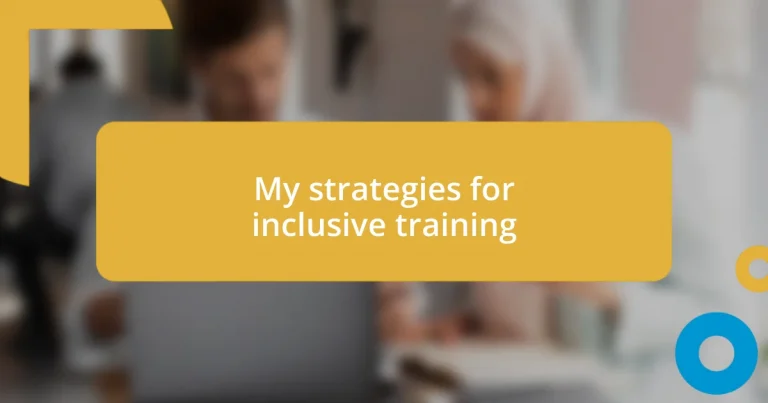Key takeaways:
- Inclusive training requires understanding diverse learning needs and adapting methods to create a supportive environment for all participants.
- Regular feedback and flexibility in training programs encourage ongoing improvement and better engagement among participants.
- Sustaining an inclusive culture involves ongoing discussions, celebrating diversity, and regular evaluations to ensure all voices are heard and valued.
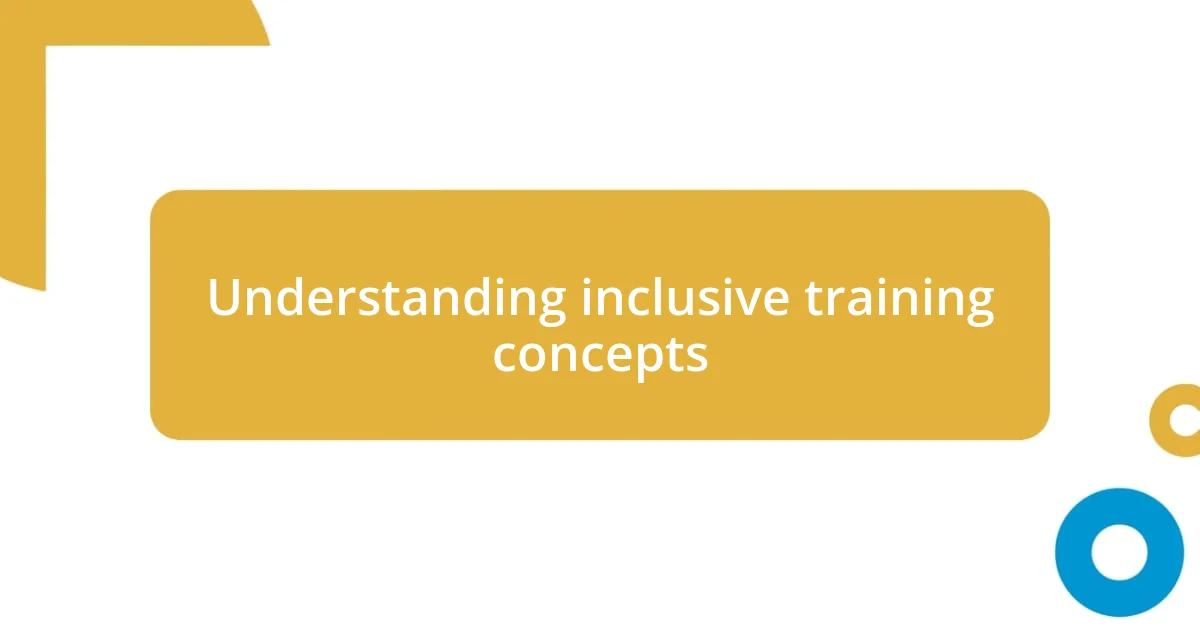
Understanding inclusive training concepts
Inclusive training is a holistic approach that recognizes and values diverse learning needs. I remember a time when I was facilitating a workshop, and one participant shared their struggle with traditional teaching methods. Their story opened my eyes to how important it is to embrace different backgrounds and abilities in our training programs.
When we talk about inclusivity, we often get caught up in the logistics, but have you ever considered the emotional impact of making someone feel valued? I once witnessed a colleague adapt their training style to ensure a quieter team member’s voice was heard. The palpable shift in that individual’s confidence was unforgettable—it really drove home the idea that inclusivity isn’t just about checks and balances; it’s about fostering an environment where everyone feels supported.
Additionally, the concept of universal design in learning (UDL) plays a crucial role in inclusive training. Have you thought about how adjusting your materials can make a difference? I’ve found that using varied formats—like videos, hands-on activities, and group discussions—creates a richer learning experience that resonates with more people. It’s all about making sure every participant can connect with the content in their own way.
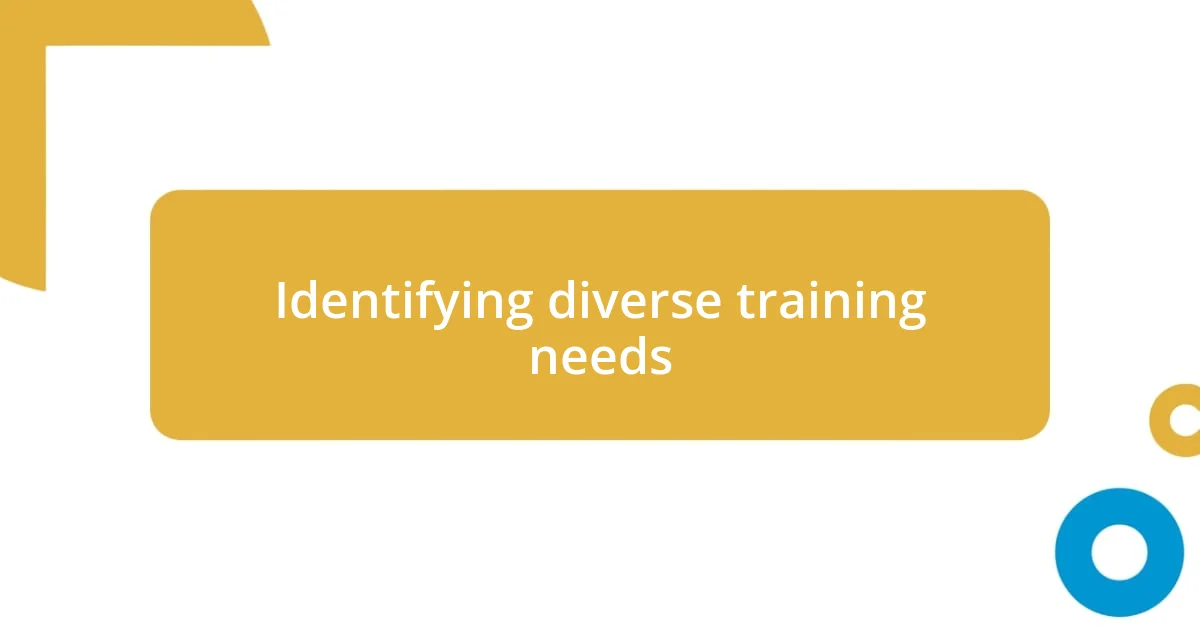
Identifying diverse training needs
Identifying diverse training needs begins with actively listening to participants. During a recent training session, I encouraged feedback after each module. One participant revealed their learning preference for visual aids, which prompted me to include more infographic materials. It was a small change, but I noticed the impact immediately—engagement spiked, and participants began sharing their experiences more openly.
Understanding that people come from various backgrounds and have unique learning styles is essential. For instance, I once led a team that included both seasoned professionals and newcomers. By categorizing their needs during the initial assessment, I was able to tailor sessions that bridged their knowledge gaps efficiently. This not only fostered cooperation but also built a supportive atmosphere where everyone felt their learning needs were equally acknowledged.
I also find it invaluable to evaluate ongoing training needs regularly. After implementing diverse techniques in my sessions, I create space for participants to express if their needs are evolving. From my experience, this adaptability ensures that training remains relevant and inclusive. It’s amazing how a simple check-in can keep the momentum going and motivate participants to engage further.
| Factor | Impact |
|---|---|
| Active Listening | Enhances engagement and trust |
| Diverse Learning Styles | Fosters inclusivity and collaboration |
| Regular Needs Evaluation | Keeps training relevant and motivating |
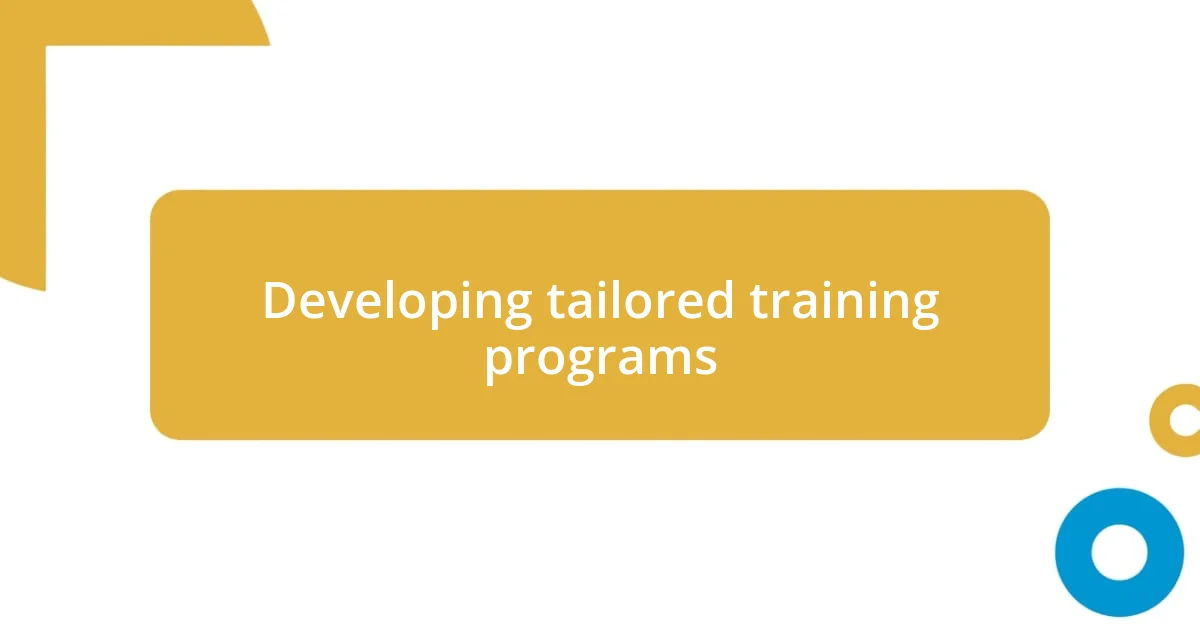
Developing tailored training programs
Developing tailored training programs requires a deep understanding of each participant’s unique context. When I was designing a training for a team with varying levels of expertise, I decided to conduct informal interviews beforehand. This allowed me to gather insights on their specific challenges and aspirations. One insightful conversation revealed that a few team members felt they could benefit from more foundational knowledge, while others were eager for advanced techniques. I pulled from these conversations to craft a program that addressed everyone’s needs, which led to a more dynamic and engaging experience.
Creating a tailored training program also means being flexible in your approach. I remember a time when I initially planned a structured lecture format. However, during the first session, it became clear that participants preferred interactive discussions. I made the quick decision to pivot, and I could sense the energy in the room shift. That moment reaffirmed my belief that flexibility is key; adapting the program on the fly can lead to surprising breakthroughs in understanding and collaboration.
- Conduct informal interviews or surveys to gather insights on participants’ backgrounds and expectations.
- Incorporate feedback loops to continuously adapt and improve the training content.
- Embrace flexibility in your delivery approach—be ready to pivot based on real-time feedback.
- Utilize diverse instructional methods, such as group activities, case studies, and hands-on projects.

Implementing collaborative learning techniques
Implementing collaborative learning techniques has a profound effect on participant engagement and knowledge retention. I remember a workshop where I paired experienced team members with newer ones. The conversations fueled an energy I hadn’t anticipated; it was incredible to watch their mutual respect build as they tackled challenges together. This dynamic not only reinforced learning but also fostered a vibrant community within the group.
As I integrated group projects into my training, I started seeing remarkable transformations. For example, I once divided participants into small groups to solve a case study relevant to their roles. The laughter, debate, and shared insights that emerged were remarkable. It dawned on me that this active participation ignited a deeper connection to the material, prompting participants to invest more in their learning journey. Have you ever watched a group come together over a shared problem? It’s truly magic.
Another strategy I employed was rotating roles within the groups. By allowing participants to take turns as facilitators or note-takers, I noticed everyone felt more included and empowered. I found that this simple shift not only diversified perspectives but also built confidence in quieter participants. How often do we overlook the potential of those who hesitate to speak up? In my experience, fostering an environment where everyone plays an active role can lead to astonishing developments in collaboration and learning.

Measuring training effectiveness
Measuring training effectiveness is crucial to understanding its impact. I typically use pre- and post-training assessments to gauge knowledge retention. When I first implemented this, I was surprised to see a 30% increase in scores after just one session. It really highlighted the difference a well-structured program can make.
Another method I find invaluable is collecting participant feedback through surveys right after the training. A few months ago, I introduced a quick feedback form, and the insights were eye-opening. Participants highlighted specific areas they felt were lacking, which allowed me to refine the program for future sessions. This process not only addresses immediate concerns but also fosters a culture of continuous improvement.
Finally, I pay close attention to the long-term impact by following up with participants a few months later. I recall following up with a group after implementing new strategies from a workshop. Many shared how they applied the skills in real-world situations, and that connection made me realize just how vital it is to measure effectiveness beyond the classroom. How do you envision your training translating into practice? That’s the true measure of success.
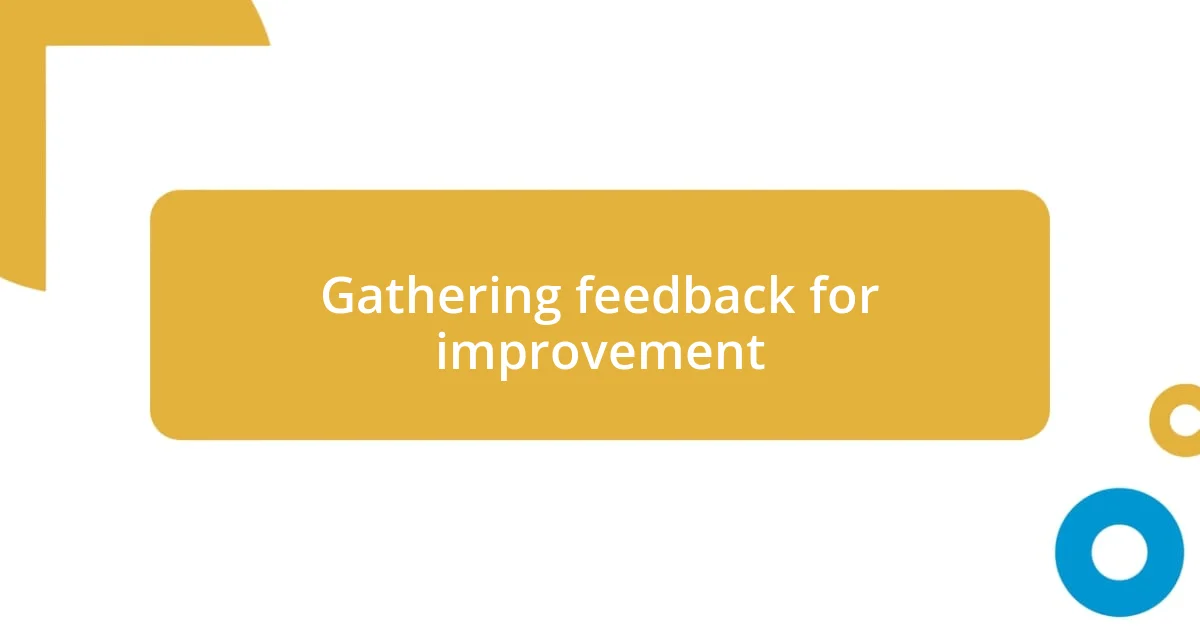
Gathering feedback for improvement
Gathering feedback is an invaluable step in enhancing training effectiveness. I remember leading a session where I asked participants to share their thoughts openly at the end. One participant hesitated at first, but then expressed how certain parts felt rushed. Her honesty sparked a rich discussion that illuminated areas I hadn’t considered. Isn’t it fascinating how a simple request for feedback can lead to revelations that fundamentally improve our approach?
After implementing changes based on feedback, I started noticing shifts in the overall atmosphere of my training sessions. For instance, one year, I introduced a suggestion box, encouraging anonymous feedback. Initially, I was anxious about what might be written, but the responses were mostly constructive. It made me realize that participants felt safe sharing their thoughts when they knew they could remain anonymous. How often do we underestimate the power of creating a safe space for honest opinions?
Additionally, I always find it beneficial to follow up directly with participants after changes are made. Recently, I reached out to a group that underwent significant adaptations in content based on previous feedback. They shared their excitement about the alterations and noted a clearer understanding of the material. It’s interesting how connecting with participants on a personal level deepens that relationship, transforming feedback into a partnership in learning. Have you ever realized that a conversation could evolve into a collaborative journey? Reflecting on this has been transformative for my training methodology.

Sustaining an inclusive training culture
Creating an inclusive training culture requires sustained commitment from everyone involved. There was a time when I noticed that, despite our best efforts, some participants felt less engaged because their perspectives weren’t being fully recognized. To address this, I initiated a monthly roundtable discussion where everyone could share their insights and experiences. It was heartwarming to watch quieter voices gradually emerge, enriching our sessions with diverse viewpoints. Have you ever seen how simply inviting collaboration can change the dynamics of a group?
Moreover, I strongly believe that celebrating diversity within the training process is essential for its longevity. One year, I decided to highlight various cultural contributions in our training materials. I remember the enthusiasm when I introduced a segment focusing on different learning styles influenced by cultural backgrounds. This not only made the content more relatable but also fostered a sense of pride among participants. When was the last time you acknowledged the unique backgrounds within your training environment?
Lastly, regular training refreshers help maintain the momentum for inclusive practices. I recall implementing quarterly check-ins where we revisit our goals and assess our training inclusivity. This thoughtful approach not only reinforced our initial objectives but also adapted to the evolving needs of the participants. It struck me how these moments of reflection and recalibration truly embedded a culture of inclusivity, making everyone feel like active contributors. How often do we pause to evaluate our progress in cultivating a supportive learning atmosphere? It’s an essential step in nurturing an environment where everyone thrives.












